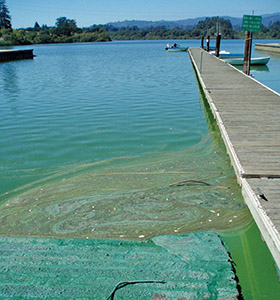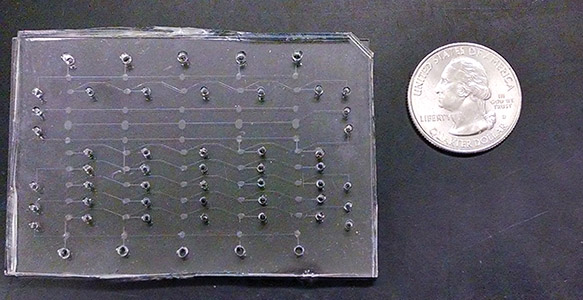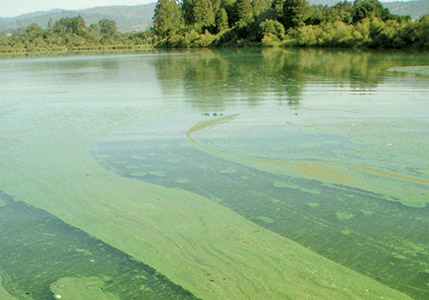The United States Environmental Protection Agency (EPA) has awarded a $300,000 Small Business Innovation Research grant to Berkeley-based HJ Science & Technology to develop an instrument that allows fast on-site testing of water to determine the presence of dangerous levels of cyanotoxins, the poisonous toxins produced when blue-green algae reproduces in high concentrations.

Pinto Lake near Watsonville is popular with boaters and fisherman, and frequently experiences toxic algal blooms during warmer months. Closer to home, the San Francisco Bay Delta and Lake Temescal in Oakland are susceptible to cyanotoxin contamination. Photo courtesy of epa.gov
By Bill Picture
Published: December, 2014
“You can’t tell just by looking whether water is safe or not,” said HJ Science & Technology President and founder Dr. Hong Jiao. “Water can be totally green from algae and not be harmful. In fact, it’s probably safe 90 percent of the time. But you can’t be sure without doing a thorough analysis.”
Until now, testing water for cyanotoxins has meant collecting samples at the source and then sending those samples to a laboratory facility—sometimes a few cities or even counties away—for analysis, a process that typically takes several days from start to finish. Because the process itself is clunky and the testing expensive, municipal utility companies drawing water from vulnerable sources typically test their water only once a week. This periodic testing creates gaps in the monitoring such that cyanotoxin contamination can occur between the times that samples are collected.
The ineffectiveness of this traditional means of testing drinking water became evident last summer when residents of Toledo, Ohio, were ordered not to drink or use water from the tap. Toledo draws its drinking water from Lake Erie, which had experienced a massive algal bloom. The water looked more like a green smoothie, and city officials feared that cyanotoxin levels could be high enough to pose a public health risk.
There must be a better way
Cyanotoxins are so potent that they’ve been studied by the U.S. military as a potential biological weapon. Ingested by humans, cyanotoxins typically cause mild diarrhea and nausea, but deaths have occurred among elderly persons and those with compromised immune systems. There are also theories that cyanotoxins could be a cause of neurodegenerative diseases such as ALS and Altzheimer’s.
The “perfect storm” that creates the algal blooms responsible for cyanotoxin contamination is a combination of warm temperatures and high nutrient concentrations. In the case of Toledo, the culprit was runoff of chemical fertilizers into Lake Erie.
After a weeklong ban on tap water, it was determined that standard water treatment methods were doing the job removing the contaminants from Toledo’s drinking water. Still, some wondered if more frequent testing wasn’t necessary, because contamination levels can vary greatly from one weekly test to the next.
“They don’t have the capability to do this every day,” said Jiao. “With our technology, they could this daily, or even multiple times a day.”
HJ Science & Technology’s portable lab is about the size of a shoebox and contains a chip that does in 45 minutes what takes lab technicians working in a full-size facility several days to accomplish. The company has been developing the technology since 2012, and used money from a previous EPA grant to get this far. The money from this Phase II grant will be used to conduct field testing and to develop the chip so that it can be mass-produced, keeping the end price within the reach of users.
“EPA’s investment won’t be enough to get this all the way to market, but it helps,” said April Richards, manager of the Small Business Innovation Research program at EPA. “That is the goal, to get this out there into the market and have it be used. The fact is, this [water contamination] problem is only going to get worse with climate change and the other contributing factors.”
What about California’s tap water?
Jiao said that, while California reservoirs could be vulnerable to contamination, Californians are more at risk of recreational exposure to cyanotoxins. HJ Science & Technology intends to conduct its first round of field tests at Pinto Lake near Watsonville. The lake is popular with boaters and fisherman, and frequently experiences toxic algal blooms during warmer months.
Closer to home, the San Francisco Bay Delta and Lake Temescal in Oakland are susceptible to cyanotoxin contamination. Recreational exposure to cyanotoxins can, in addition to the problems described above, cause allergic-like reactions like skin rashes.
“Of course, once you know that cyanotoxins are present, there isn’t anything that can be done to remedy it,” Jiao said. “Nature just has to take its course, and eventually the levels will come down on their own. But we need to be able to warn people so that they’re not unknowingly being exposed to something that can make them very sick.”
EPA’s Small Business Innovation Research program began in 1982. Richards said that HJ Science & Technology was one of 23 proposals to receive Phase I funding last year, out of 260 total proposals received. Only nine, including HJ Science & Technology, received Phase II funding. Out of all the recipients, Richards estimated that 25 percent go on to grow successful businesses.
“It’s tough to get any idea off the ground, but even tougher for a green business, I think,” said Richards. “The private sector looks at ideas like this one as high risk, and they’re not willing to take that risk. They want a known return on their investment, which companies like this can’t provide.”
“This is a huge deal for us,” said Jiao. “We’re on track and if all goes well, we could be hitting the market in three years. Without this grant, that wouldn’t be possible, we couldn’t get to the next level.”
For more information on HJ Science & Technology, visit www.hjsciencetech.com.
For more information on the EPA’s Small Business Innovation Research program, visit www.epa.gov/ncer/sbir.

HJ Science & Technology’s portable lab is about the size of a shoebox and contains a small chip that does in 45 minutes what takes lab technicians working in a full-size facility several days to accomplish. HJ Science & Technology Inc.

Until now, testing water for cyanotoxins has meant collecting samples at the source and then sending those samples to a laboratory facility for analysis, a process that typically takes several days from start to finish. Photo courtesy of epa.gov

